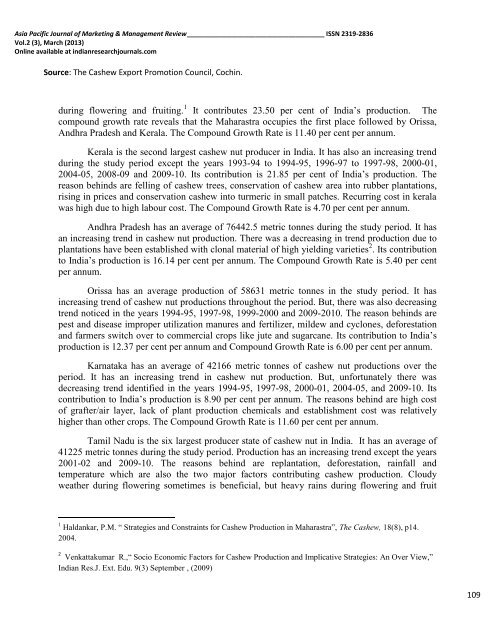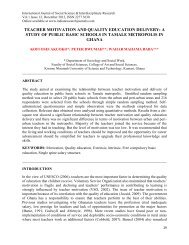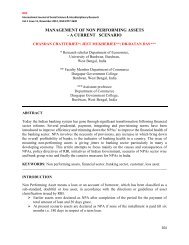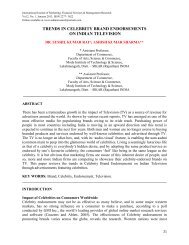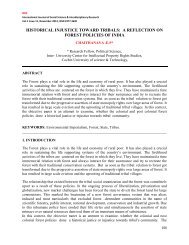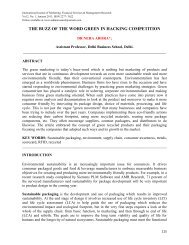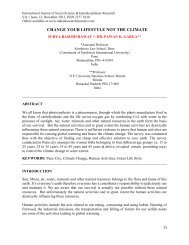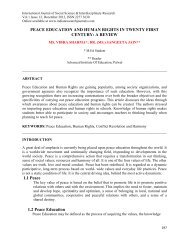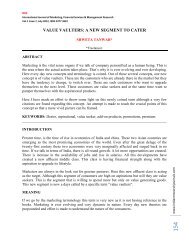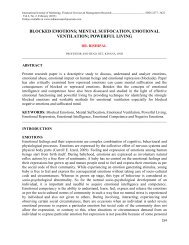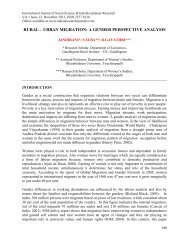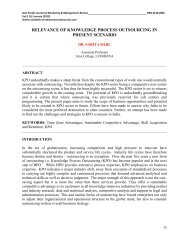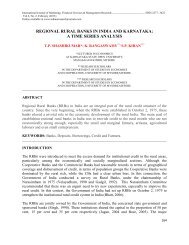analysis of cashew nut production in india - Indianresearchjournals ...
analysis of cashew nut production in india - Indianresearchjournals ...
analysis of cashew nut production in india - Indianresearchjournals ...
Create successful ePaper yourself
Turn your PDF publications into a flip-book with our unique Google optimized e-Paper software.
Asia Pacific Journal <strong>of</strong> Market<strong>in</strong>g & Management Review______________________________________ ISSN 2319-2836<br />
Vol.2 (3), March (2013)<br />
Onl<strong>in</strong>e available at <strong>in</strong>dianresearchjournals.com<br />
Source: The Cashew Export Promotion Council, Coch<strong>in</strong>.<br />
dur<strong>in</strong>g flower<strong>in</strong>g and fruit<strong>in</strong>g. 1 It contributes 23.50 per cent <strong>of</strong> India‟s <strong>production</strong>. The<br />
compound growth rate reveals that the Maharastra occupies the first place followed by Orissa,<br />
Andhra Pradesh and Kerala. The Compound Growth Rate is 11.40 per cent per annum.<br />
Kerala is the second largest <strong>cashew</strong> <strong>nut</strong> producer <strong>in</strong> India. It has also an <strong>in</strong>creas<strong>in</strong>g trend<br />
dur<strong>in</strong>g the study period except the years 1993-94 to 1994-95, 1996-97 to 1997-98, 2000-01,<br />
2004-05, 2008-09 and 2009-10. Its contribution is 21.85 per cent <strong>of</strong> India‟s <strong>production</strong>. The<br />
reason beh<strong>in</strong>ds are fell<strong>in</strong>g <strong>of</strong> <strong>cashew</strong> trees, conservation <strong>of</strong> <strong>cashew</strong> area <strong>in</strong>to rubber plantations,<br />
ris<strong>in</strong>g <strong>in</strong> prices and conservation <strong>cashew</strong> <strong>in</strong>to turmeric <strong>in</strong> small patches. Recurr<strong>in</strong>g cost <strong>in</strong> kerala<br />
was high due to high labour cost. The Compound Growth Rate is 4.70 per cent per annum.<br />
Andhra Pradesh has an average <strong>of</strong> 76442.5 metric tonnes dur<strong>in</strong>g the study period. It has<br />
an <strong>in</strong>creas<strong>in</strong>g trend <strong>in</strong> <strong>cashew</strong> <strong>nut</strong> <strong>production</strong>. There was a decreas<strong>in</strong>g <strong>in</strong> trend <strong>production</strong> due to<br />
plantations have been established with clonal material <strong>of</strong> high yield<strong>in</strong>g varieties 2 . Its contribution<br />
to India‟s <strong>production</strong> is 16.14 per cent per annum. The Compound Growth Rate is 5.40 per cent<br />
per annum.<br />
Orissa has an average <strong>production</strong> <strong>of</strong> 58631 metric tonnes <strong>in</strong> the study period. It has<br />
<strong>in</strong>creas<strong>in</strong>g trend <strong>of</strong> <strong>cashew</strong> <strong>nut</strong> <strong>production</strong>s throughout the period. But, there was also decreas<strong>in</strong>g<br />
trend noticed <strong>in</strong> the years 1994-95, 1997-98, 1999-2000 and 2009-2010. The reason beh<strong>in</strong>ds are<br />
pest and disease improper utilization manures and fertilizer, mildew and cyclones, deforestation<br />
and farmers switch over to commercial crops like jute and sugarcane. Its contribution to India‟s<br />
<strong>production</strong> is 12.37 per cent per annum and Compound Growth Rate is 6.00 per cent per annum.<br />
Karnataka has an average <strong>of</strong> 42166 metric tonnes <strong>of</strong> <strong>cashew</strong> <strong>nut</strong> <strong>production</strong>s over the<br />
period. It has an <strong>in</strong>creas<strong>in</strong>g trend <strong>in</strong> <strong>cashew</strong> <strong>nut</strong> <strong>production</strong>. But, unfortunately there was<br />
decreas<strong>in</strong>g trend identified <strong>in</strong> the years 1994-95, 1997-98, 2000-01, 2004-05, and 2009-10. Its<br />
contribution to India‟s <strong>production</strong> is 8.90 per cent per annum. The reasons beh<strong>in</strong>d are high cost<br />
<strong>of</strong> grafter/air layer, lack <strong>of</strong> plant <strong>production</strong> chemicals and establishment cost was relatively<br />
higher than other crops. The Compound Growth Rate is 11.60 per cent per annum.<br />
Tamil Nadu is the six largest producer state <strong>of</strong> <strong>cashew</strong> <strong>nut</strong> <strong>in</strong> India. It has an average <strong>of</strong><br />
41225 metric tonnes dur<strong>in</strong>g the study period. Production has an <strong>in</strong>creas<strong>in</strong>g trend except the years<br />
2001-02 and 2009-10. The reasons beh<strong>in</strong>d are replantation, deforestation, ra<strong>in</strong>fall and<br />
temperature which are also the two major factors contribut<strong>in</strong>g <strong>cashew</strong> <strong>production</strong>. Cloudy<br />
weather dur<strong>in</strong>g flower<strong>in</strong>g sometimes is beneficial, but heavy ra<strong>in</strong>s dur<strong>in</strong>g flower<strong>in</strong>g and fruit<br />
1 Haldankar, P.M. “ Strategies and Constra<strong>in</strong>ts for Cashew Production <strong>in</strong> Maharastra”, The Cashew, 18(8), p14.<br />
2004.<br />
2 Venkattakumar R.,“ Socio Economic Factors for Cashew Production and Implicative Strategies: An Over View,”<br />
Indian Res.J. Ext. Edu. 9(3) September , (2009)<br />
109


